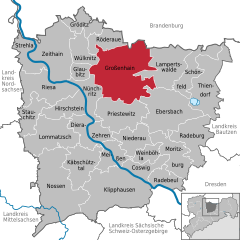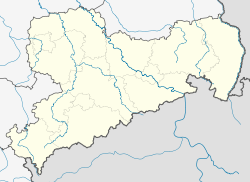world.wikisort.org - Germany
Großenhain (also written as Grossenhain; Upper Sorbian: Wulki Hojn) is a Große Kreisstadt (German for major district town) in the district of Meissen, Saxony, Germany. It was originally known as Hayne. The current name simply means "big Hayne"
Großenhain | |
|---|---|
Town | |
 Town hall | |
 Coat of arms | |
Location of Großenhain within Meissen district  | |
 Großenhain  Großenhain | |
| Coordinates: 51°17′N 13°33′E | |
| Country | Germany |
| State | Saxony |
| District | Meissen |
| Subdivisions | 5 |
| Government | |
| • Mayor (2022–29) | Sven Mißbach[1] (Ind.) |
| Area | |
| • Total | 96.79 km2 (37.37 sq mi) |
| Elevation | 122 m (400 ft) |
| Population (2020-12-31)[2] | |
| • Total | 18,062 |
| • Density | 190/km2 (480/sq mi) |
| Time zone | UTC+01:00 (CET) |
| • Summer (DST) | UTC+02:00 (CEST) |
| Postal codes | 01558; 01561 |
| Dialling codes | 03522 |
| Vehicle registration | MEI; GRH; RG; RIE |
| Website | www.grossenhain.de |
History
Großenhain was originally a Sorbian settlement, and remains an area where this language is spoken.
It was first mentioned in 1205.[3] It was for a time occupied by the Bohemians, by whom it was strongly fortified. It afterwards came into the possession of the margraves of Meissen, from whom it was taken in 1312 by the margraves of Brandenburg. In the middle-ages, Großenhain was one of the most powerful towns in Saxony.
It suffered considerably in all the great German wars, and in 1744 was nearly destroyed by fire. The fire destroyed the church which was then replaced by the current Marienkirche, which echoes internally echoes the Frauenkirche in nearby Dresden.
On May 16, 1813, a battle took place here between the French (Napoleon's army) and the Russians.
A military airfield was created near the town, opening in February 1914. From 1945 to 1993 the air base of the Soviet Air Force was located at this airfield. On the territory of the base there was also a secret Soviet military unit serving nuclear weapons stored at the base. On May 27, 1973 an aircraft technician senior lieutenant Yevgeny Vronsky hijacked a fighter-bomber Su-7BM # 52 from this base to the Federal Republic of Germany. Before that Vronsky had no experience in piloting aircraft. Nevertheless he safely crossed the border of the Federal Republic of Germany and after that was safely ejected. The plane crashed into a forest near the city of Braunschweig.
Kulturzentrum Grossenhain (the culture centre) was recently created, cleverly converting the ruined fragments of Schloss Grossenhain into a modern building.[4]
On May 24, 2010, Großenhain was hit by an rain-wrapped F3 tornado which killed 1 & injured 40 others. This event made sirens sound for 60 seconds in and around Großenhain. The fatality was a 6 year old girl who were killed by a downed tree. [5][6]
Geography


Großenhain is located on the river Röder, 30 km (19 mi) northwest of Dresden, and 17 km (11 mi) east of Riesa. It is also situated on Via Regia from Görlitz to Santiago de Compostela.
Divisions
The town Großenhain consists of Großenhain proper and the following Ortschaften or municipal divisions:[7]
- Bauda
- Colmnitz
- Folbern
- Görzig
- Nasseböhla (incl. Stroga)
- Skassa
- Skäßchen (incl. Krauschütz, Skaup and Uebigau)
- Strauch
- Walda-Kleinthiemig
- Weßnitz-Rostig
- Wildenhain
- Zabeltitz (incl. Treugeböhla)
These Ortschaften correspond with former municipalities or their divisions, that were absorbed into Großenhain between 1994 and 2010. The localities Großraschütz, Kleinraschütz, Mülbitz, Naundorf, Zschauitz and Zschieschen are former municipalities that were absorbed into Großenhain between 1913 and 1961.[8]
Infrastructure
There are two train stations in Großenhain. The Großenhain Berliner Bahnhof had been out of service since 2002, leaving only the Großenhain Cottbusser Bahnhof, served by trains from Dresden to Elsterwerda, Cottbus and Hoyerswerda.
Großenhain is accessible by car via Bundesstraße 98 and Bundesstraße 101.
Famous people

- Martin Blochwich (1602-1629): German physician, born here
- Lucas Krzikalla (born 1994): German handball player, born here
- Karl Benjamin Preusker (1786–1871): Founder of the first public library in Germany (1828)
- Manfred von Richthofen (1892–1918): German fighter pilot known as The Red Baron, was trained as observer at the local airport
- Corinna Harfouch (born 1954): German actress, passed her childhood here
- Benjamin Hedericus (1675-1748): Lexicographer
- Heino (born 1938): German schlager artist, passed his childhood here
- Carlo Mierendorff (1897-1943), representatives of the SPD, a member of the German Reichstag and resistance fighter against Nazism
- Frederick Traugott Pursh (1774-1820), actually Friedrich Pursch , botanist
- Helmut H. Schaefer (1925-2005), mathematician, professor at the University of Halle (Saale), at the University of Tübingen, at the California Institute of Technology and other US universities
- Ingo Senftleben (born 1974), German politician (CDU)
- Valentin Weigel (1533-1588), theologian and philosopher
- Frieder Zschoch (1932–2016), musicologist
References
- Gewählte Bürgermeisterinnen und Bürgermeister im Freistaat Sachsen, Stand: 17. Juli 2022, Statistisches Landesamt des Freistaates Sachsen.
- "Bevölkerung des Freistaates Sachsen nach Gemeinden am 31. Dezember 2020". Statistisches Landesamt des Freistaates Sachsen (in German). June 2021.
- Großenhain, Steifzug durch eine sächsische Kleinstadt 2002, Gräser Verlag
- "Kulturzentrum Großenhain - Kulturzentrum Großenhain".
- "Großenhain (Sachsen), 24.05.2010".
- "Vor zehn Jahren: Tornado verwüstet Großenhainer Land | MDR.DE". Archived from the original on 2021-05-18.
- Hauptsatzung der Großen Kreisstadt Großenhain, August 2019.
- Großenhain in the Digital Historic Index of Places in Saxony (Digitales Historisches Ortsverzeichnis von Sachsen)
This article incorporates text from a publication now in the public domain: Chisholm, Hugh, ed. (1911). "Grossenhain". Encyclopædia Britannica. Vol. 12 (11th ed.). Cambridge University Press. p. 617.
External links
- Official website
 (in German)
(in German)
На других языках
[de] Großenhain
Großenhain, früher als Hayn bezeichnet, ist eine Große Kreisstadt in Sachsen an der Großen Röder im Landkreis Meißen.- [en] Großenhain
[es] Großenhain
Großenhain es un poblado alemán, ubicado en el distrito de Meißen, en la región administrativa de Dresde, en el Estado Libre de Sajonia.[ru] Гросенхайн
Гросенхайн (нем. Großenhain) — город в Германии, районный центр, расположен в земле Саксония. Подчинён земельной дирекции Дрезден. Входит в состав района Риза-Гросенхайн. Население составляет 19509 человек (на 31 декабря 2010 года). Занимает площадь 43,97 км². Официальный код — 14 2 85 100.Другой контент может иметь иную лицензию. Перед использованием материалов сайта WikiSort.org внимательно изучите правила лицензирования конкретных элементов наполнения сайта.
WikiSort.org - проект по пересортировке и дополнению контента Википедии
